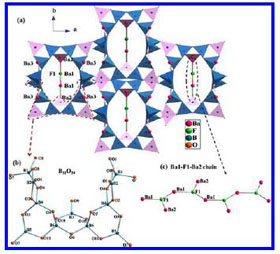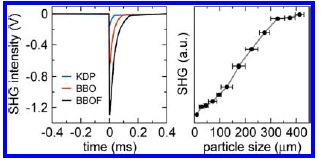Ba4B11O20F: A New NLO Material with a Large Second Harmonic Generation Response
Editor: | Apr 12,2013
Prof. PAN Shilie’s group of Xinjiang Technical Institute of Physics & Chmistry, Chinese Academe Sciences (XTIPC), with two American scientists, Prof. Kenneth R. Poeppelmeier and Prof. James M. Rondinelli, recently synthesized new UV Nonlinear optical (NLO) material systems based onfluoride borate.
NLO materials are able to halve the wavelength of light (or double the frequency) rely on the process of second harmonic generation (SHG), which occurs only when inversion symmetry is absent in a crystal. The availability of SHG materials operating in the deep-UV region is limited by fundamental requirements imposed on the crystalline structure: they should exhibit a large NLO response while also possessing a broad UV transparency window and phase matching.
Researchers employed a design strategy to realize a deep-UV material with a large SHG response by the introduction of fluorine into BBO." Our approach relies on an early observation that established a proportionality between the macroscopic NLO response and spontaneous polarization owing to lifting of the inversion symmetry by atomic displacements within a unit cell. " introduced Prof. PAN Shilie.
BBOF has a complex framework structure formed from two main units. One is a new functional building block (FBB), B11O24, composed of five B3O8 rings connected by shared O atoms to give a three-dimensional (3D) network with tunnels along the c axis (Fig. 1). Leveraging that insight, researchers synthesized Ba4B11O20F (BBOF) with a polar structure that is far from centrosymmetric, yielding an SHG response at 1064 nm exceeding that of KH2PO4 (KDP) by nearly an order of magnitude. The enhanced SHG intensity in BBOF originates mainly from F-directed polar displacements and to a lesser extent from the Ba polarizability (Fig.2). These features are captured within our theoretical framework integrating a crystallographic descriptor model with electronic structure calculations.
The result as a communicationhas been published on J. Am. Chem. Soc.,2013, 135(11), 4215-4218. The work has been supported by the National Natural Science Foundation of China, Chinese Academy of Sciences.

Fig1. The 3D framework of BBOF (Ba-O bonds omitted for clarity )

Fig 2. SHG intensities of BBOF and phase-matching curve of BBOF
Contact:
PAN Shilie
E-mail:slpan@ms.xjb.ac.cn
附件下载:
 (86) 991-3838931
(86) 991-3838931 lhskj@ms.xjb.ac.cn
lhskj@ms.xjb.ac.cn (86)991-3838957
(86)991-3838957 40-1 Beijing Road
Urumqi, XinjiangChina
40-1 Beijing Road
Urumqi, XinjiangChina